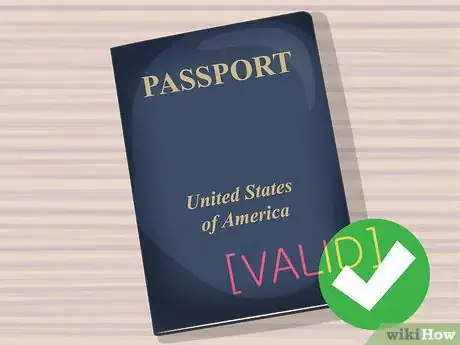This article was co-authored by Allyson Edwards. Allyson Edwards graduated from Stanford University with a BA in International Relations. Afterwards, she went on to facilitate International partnerships with agencies in over twenty countries, and has consulted for companies in industries across education, fintech, and retail.
There are 21 references cited in this article, which can be found at the bottom of the page.
wikiHow marks an article as reader-approved once it receives enough positive feedback. In this case, 90% of readers who voted found the article helpful, earning it our reader-approved status.
This article has been viewed 45,516 times.
Planning to mark a trip to South Korea off your bucket list? You’ll need to plan ahead to make sure you have your passport ready and work to get the best rates on airline tickets. From there, you’ll need to know some basics about the country, like their currency, public transit, and some awesome places to visit. Once you have all that covered, you are ready for a memorable experience. Adventure awaits!
Steps
Preparing for Your Trip
-
1Make sure your passport is current and will be valid for at least 3 months. Visas aren’t required to enter South Korea, but you will need your passport to re-enter your home country.[1] If you have less than 3 months until the expiration date, you will need to renew your passport.
- You’ll want to start on this early because it can take up to 8 weeks to receive your new passport. Even if you choose to pay the extra fee to have it expedited, it can still take 2-3 weeks to receive.[2]
-
2Learn some basic Korean phrases to help you communicate. Most Koreans speak only their native language, even in touristy areas. Phrases like “hello” 안녕하세요 (an-nyog-ha-se-yo), “excuse me” 실례합니다 (shil-lye-ham-ni-da), “thank you” 감사합니다 (gam-sa-ham-ni-da), and “I’m lost” 길을 잃었어요 (gir-eul ir-oss-o-yo.) are good starts, but you may want to get some other Korean basics down as well.[3]Advertisement
-
3Consider the weather during your travel time so you can pack properly. Spring and fall (April, May, June, and September, October, November) have mild weather that is typically sunny and dry.[6] If you are traveling during these months, it should be pretty easy to pack with pants, short and long sleeve tops, and a light a jacket.
Booking Travel and Accomodations
-
1Research airfare prices online to find the best deals. This is something else you will want to do well in advance. You can get the best prices on flights to Asia when tickets are purchased at least 90 days before your travel date.[9]
- Airline companies often run special promotions, so booking directly through them during those times is a good idea.
- Don’t forget to check travel companies like Orbitz and Expedia because sometimes they end up having really good deals. They also offer special packages that include airfare, hotel, and transportation, which may save you some money.[10]
-
2Make arrangements for lodging. Consider how many people are traveling in your group, and what kind of experience you are looking for. Lodging in South Korea ranges from standard hotels and resorts to traditional-style housing, or hostels and community sleeping centers.
- If you want to stay somewhere more modern or upscale, like a luxury hotel or resort, you’ll want to book in advance. Don’t wait until the last minute as they usually book up fast or charge higher prices for late bookings.[11]
- For a uniquely Korean experience, stay in a hanok, which is traditional Korean housing. They feature privacy, incredible architecture, and beautiful gardens.[12] It’ll cost you a little more to stay here, but you’ll be glad you had the experience!
- If you just need a place to rest a little while you are on the go, check out a Jjimjilbang, which is basically a community sauna with a heated floor that will cost you the equivalent of just a few dollars to sleep on.[13]
-
3Plan to utilize taxis or public transportation to get around. Taxis are abundant and affordable, and there is no need to tip your driver. Subways are inexpensive and convenient, and signs are posted in Korean as well as English. Use them if you are visiting Seoul, Busan, Daejeon, Daegu, Gwangju or Incheon.[14]
- Renting a car to drive yourself might not be a great idea--road systems are complex and traffic is dense. Plus, you have to be over 21 to have an international driver’s permit.[15]
Making the Most of Your Vacation
-
1Visit a foreign exchange bank when you arrive to get Korean money. You can buy traveler’s cheques or exchange money for South Korean Won (₩), which is the official currency. You’ll want to keep some bills and coins on hand since some smaller merchants, or those in rural areas, may not accept traveler's cheques.[16]
- The exchange rate is always changing, so check the current rate when you arrive to give you a good idea of how much money you should convert.
- Most major credit cards are accepted in larger cities, but be aware that you may be charged a foreign transaction fee for using them.[17]
-
2Spend some time sightseeing to create a memorable experience. South Korea is full of famous landmarks, beautifully landscaped beaches, and mountains with stunning views.[18] It would be impossible to see all of them, but definitely make some time to visit at least a couple.
-
3Go bird watching at Suncheon Bay, one of the world’s biggest coastal marshes. Enjoy the breathtaking scenery and learn a little about science and nature at the Eco-Museum or Observatory.
- Entry will cost you 8000₩ for adults, 4000-6000₩ for youth, and children under 6 years old are free.[19]
- Take a break to play and go on a ride on the ferris wheel for a small additional fee!
-
4Ski or snowboard the perfect slopes at Taebaek Mountain. These mountains are said to have the best snow in the country, which might be why they are hosting the 2018 Winter Olympics.[20] If you are a fan of winter sports or activities, you have to check it out!
- For the most value for your money, try YongPyong Resort, which features over 15 miles (24 km) of slopes and 15 lifts. Day ticket prices are about 76,000₩ for adults and 61,000₩ for children.
-
5Take a leisurely stroll through the historical Anapji Pond. This man-made pond originally served as the Crown Prince’s headquarters.[21] Get a quick history lesson while being amazed at the beautiful scenery and architecture.
- This outing will cost you about 2000₩ for adults, 1200₩ for teenagers, and 600₩ for children. They do offer group rates as well.[22]
-
6Shop til you drop in one of the world’s best shopping cities! If you find yourself in Seoul, your trip wouldn’t be complete without a shopping trip. This capital city is jam-packed with luxury department stores, large fashion malls, and street carts lining the city blocks. [23]
- Doota shopping mall and 10 Corso Como offer super-trendy shopping, while Namdaemun Market is home of the biggest traditional Korean market for local and handmade goods.
Community Q&A
-
QuestionHow can I go to Korea if I don't have a passport?
 Community AnswerYou cannot go to a foreign country without a passport; a passport is necessary for international travel.
Community AnswerYou cannot go to a foreign country without a passport; a passport is necessary for international travel. -
QuestionHow do I apply for a visa to visit South Korea?
 Community AnswerIf you need a visa you can apply at the airport (usually), online, or at a South Korean embassy.
Community AnswerIf you need a visa you can apply at the airport (usually), online, or at a South Korean embassy.
Warnings
- If you go anywhere near the Demilitarized Zone, be very careful.⧼thumbs_response⧽
References
- ↑ https://www.worldtravelguide.net/guides/asia/south-korea/passport-visa/
- ↑ https://passportinfo.com/passport-renewal/
- ↑ https://www.fluentu.com/blog/korean/korean-travel-phrases/
- ↑ https://www.fluentu.com/blog/korean/online-korean-course/
- ↑ https://www.fluentu.com/blog/korean/korean-translator-app/
- ↑ https://www.selectiveasia.com/south-korea-holidays/weather
- ↑ https://www.selectiveasia.com/south-korea-holidays/weather
- ↑ https://www.selectiveasia.com/south-korea-holidays/weather
- ↑ https://www.cnbc.com/2017/05/11/whens-the-best-time-to-book-a-flight.html
- ↑ https://www.nytimes.com/2011/02/27/travel/27prac-vacationpackage.html
- ↑ https://www.smartertravel.com/2017/06/19/stay-south-korea-lodging-tips/
- ↑ http://travel.cnn.com/seoul/visit/5-reasons-stay-hanok-while-traveling-korea-813242/
- ↑ http://www.englishspectrum.com/handling-your-first-jjimjilbang-and-mokyoktang-experience-like-a-pro-part-i-the-jjimjilbang/
- ↑ https://www.lonelyplanet.com/south-korea/transport/getting-around/local-transport
- ↑ https://www.worldtravelguide.net/guides/asia/south-korea/getting-around/
- ↑ https://www.worldtravelguide.net/guides/asia/south-korea/money-duty-free/
- ↑ https://www.nerdwallet.com/blog/credit-cards/foreign-transaction-fee/
- ↑ https://www.cnn.com/travel/article/south-korea-beautiful-places/index.html
- ↑ http://www.suncheonbay.go.kr/?r=ENG&c=240/358
- ↑ https://www.forbes.com/sites/davidbressan/2018/02/10/winter-olympics-geology-perfect-ski-slopes-are-the-results-of-250-million-years-of-earths-history/#50a3605e4a89
- ↑ http://www.art-and-archaeology.com/korea/gyeongju/an01.html
- ↑ https://thisiskoreatours.com/project/anapji-wolji-pond/
- ↑ https://www.cnn.com/travel/article/worlds-best-shopping-cities/index.html







































































